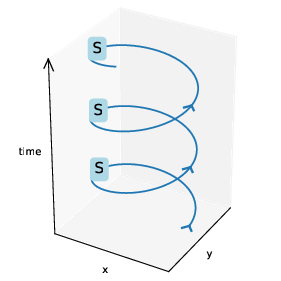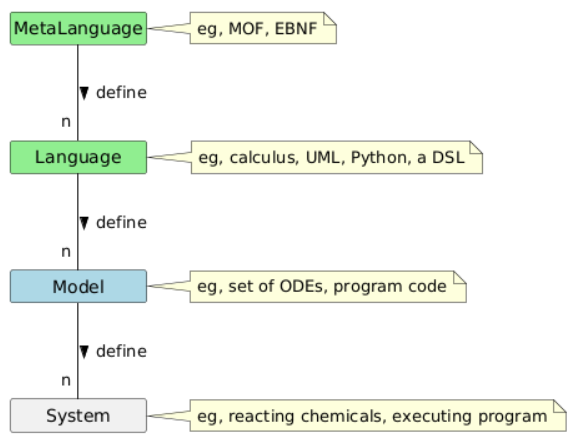Open Questions about Time and Self-reference in Living Systems (2508.11423v1)
Abstract: Living systems exhibit a range of fundamental characteristics: they are active, self-referential, self-modifying systems. This paper explores how these characteristics create challenges for conventional scientific approaches and why they require new theoretical and formal frameworks. We introduce a distinction between 'natural time', the continuing present of physical processes, and 'representational time', with its framework of past, present and future that emerges with life itself. Representational time enables memory, learning and prediction, functions of living systems essential for their survival. Through examples from evolution, embryogenesis and metamorphosis we show how living systems navigate the apparent contradictions arising from self-reference as natural time unwinds self-referential loops into developmental spirals. Conventional mathematical and computational formalisms struggle to model self-referential and self-modifying systems without running into paradox. We identify promising new directions for modelling self-referential systems, including domain theory, co-algebra, genetic programming, and self-modifying algorithms. There are broad implications for biology, cognitive science and social sciences, because self-reference and self-modification are not problems to be avoided but core features of living systems that must be modelled to understand life's open-ended creativity.
Collections
Sign up for free to add this paper to one or more collections.
Summary
- The paper distinguishes between natural time and representational time, showing how self-reference enables anticipatory behavior and open-ended evolution.
- It introduces a three-level framework for novelty that bridges variation, innovation, and transformation in biological and computational systems.
- The study highlights the need for new mathematical and computational models to capture dynamic, self-modifying processes in living and social systems.
Open Questions about Time and Self-reference in Living Systems
Introduction
This paper addresses foundational issues at the intersection of biology, philosophy, mathematics, and computation, focusing on the roles of time, self-reference, and self-modification in living systems. The authors argue that living systems—biological and social—are fundamentally distinct from typical physical systems due to their capacity for self-reference and self-modification, and that these features challenge the adequacy of conventional scientific and mathematical frameworks. The paper introduces a critical distinction between "natural time" (the ongoing present of physical processes) and "representational time" (the past-present-future framework emergent in living systems), and explores how this distinction is essential for understanding memory, learning, prediction, and the open-ended creativity of life.
Natural Time vs. Representational Time
The authors distinguish between two conceptions of time:
- Natural time is the continuous, unidirectional flow experienced by physical systems, characterized by a perpetual present with no intrinsic access to past or future.
- Representational time emerges with living systems and is necessary for memory, anticipation, and learning. It enables agents to encode and act upon representations of past and future, thus supporting agency and survival.
This distinction is not merely semantic but foundational: representational time is not a mere mapping of natural time, but a new ontological category that enables living systems to transcend the limitations of purely reactive behavior. The emergence of representational time is posited as a necessary condition for the anticipatory and creative capacities of life.
Self-reference, Paradox, and the Role of Time
Self-reference is central to living systems, manifesting in phenomena ranging from DNA self-replication to the recursive modeling of self in cognition and society. In formal systems, self-reference is often pathological, leading to paradoxes such as Russell's paradox or the Liar paradox. The authors argue that these paradoxes can be resolved by embedding self-reference within natural time: what appears as a logical contradiction in a timeless formalism becomes a dynamic process—often an oscillation or spiral—when viewed temporally.

Figure 2: (a) A system S referring to itself; (b) adding time unwinds self-reference into a temporal sequence, resolving paradoxes as dynamic processes.
This temporal "unwinding" of self-reference is exemplified by the transformation of the Liar paradox into a temporal oscillator, and by the developmental spirals observed in biological morphogenesis and evolution.
Life as an Essentially Temporal, Iterative Process
The paper emphasizes that life is fundamentally temporal, not only because it exists in time but because its core processes—evolution, development, learning—are inherently iterative and computationally irreducible. Evolution is framed as an iterative generate-and-test process, where each generation builds upon the previous, and where the mechanisms of variation and selection themselves can evolve. Embryogenesis and morphogenesis are similarly iterative, involving the alignment and differentiation of cells through recursive feedback and structural coupling.
The authors note the absence of known non-iterative mechanisms capable of exploring the vast state space of biological possibility, highlighting the essentiality of temporality for open-ended evolution and development.
The Emergence and Maintenance of Self
The concept of "self" is analyzed through the lenses of second-order cybernetics, autopoiesis, and enactivism. The self is not a static entity but a dynamic process of organizational closure and structural coupling with the environment. The observer's role in distinguishing and maintaining the self is emphasized, as is the recursive nature of self-production and self-maintenance.

Figure 1: The relationship between systems, their models, the languages (metamodels) used to define models, and the metalanguages used to define languages.
The paper discusses how self-reference, when situated in natural time, avoids paradox by treating the self as a process that is never identical to itself at different times, but maintains coherence through recursive, temporally extended operations.
Open-endedness and Levels of Novelty
A key contribution is the formalization of open-endedness in terms of levels of novelty:
- Level 0 (variation): Changes in system instances.
- Level 1 (innovation): Changes in the system model.
- Level 2 (transformation): Changes in the metamodel or language.
Open-ended systems are defined as those that continually produce level-1 and level-2 novelties. The authors argue that most existing mathematical and computational frameworks are static at the model or metamodel level, and thus inadequate for capturing the open-ended creativity of living systems.
Mathematical and Computational Tools for Self-referential Systems
The paper surveys mathematical approaches to self-reference:
- Domain theory: Provides spaces isomorphic to their own function spaces, enabling self-application and fixpoints, but at the cost of partiality and limited applicability to open-ended systems.
- Coalgebra: Offers a dual to algebraic induction, supporting the modeling of infinite, self-referential processes, but with limitations in capturing the full expressiveness of self-modification.
- Calculus of Indications (Spencer-Brown): Models self-reference as the generative source of temporal dynamics, with applications to autopoiesis and recursive biological processes.
On the computational side, the authors discuss:
- Genetic Programming (GP): Enables the evolution of programs (models), and, with meta-level modification, the evolution of evolutionary operators (metamodels). However, GP is typically limited to external modification.
- Memory Evolutive Systems (MES): A categorical framework allowing for the evolution of both system structure and modeling relations, supporting hierarchical emergence and dynamic meta-modeling.
- Self-modifying code and reflection: True open-endedness requires programming languages and systems capable of self-inspection and self-modification at all levels, a feature largely absent from mainstream computational practice.
The authors highlight the need for new programming paradigms and mathematical theories that support dynamic, self-referential, and self-modifying systems, both for modeling biological and social phenomena and for advancing artificial life and AI.
Applications and Analysis
The paper reviews applications in biology (e.g., (M,R)-systems, autopoiesis), economics (dynamic models with evolving agent types), and game theory (games with changing numbers of players and rules). In each case, the challenge is to model systems where the rules of interaction, the agents themselves, and the boundaries between self and environment are dynamic and subject to self-modification.
The analysis of such systems is inherently difficult, as open-ended evolution can move systems outside the scope of their initial models, rendering conventional predictive and calibration techniques inadequate. The authors suggest that progress will require the development of new analysis tools, likely inspired by behavioral neuroscience, artificial life, and evolutionary computation.
Implications and Future Directions
The paper's central claim is that self-reference, self-modification, and time are not peripheral complications but core features of living systems that must be embraced and formally modeled. Theoretical implications include the need to revise foundational assumptions in mathematics, computation, and the philosophy of science, particularly regarding the nature of representation, agency, and emergence.
Practically, the work points toward the development of new mathematical and computational frameworks—potentially grounded in category theory, coalgebra, and reflective programming—that can accommodate the open-ended, self-modifying dynamics of living and social systems. The authors note that cultural and methodological barriers remain significant, particularly the reluctance to cede control to models that can autonomously transform themselves.
Conclusion
This paper provides a comprehensive and rigorous analysis of the challenges posed by time, self-reference, and self-modification in living systems. By distinguishing between natural and representational time, and by formalizing levels of novelty and open-endedness, the authors lay the groundwork for a new theoretical paradigm. The implications extend across biology, cognitive science, social science, and AI, demanding new mathematical and computational tools capable of modeling the open-ended creativity and reflexivity of life. The path forward will require both conceptual innovation and the development of practical systems that can model, simulate, and analyze self-modifying, evolving, and open systems.
Follow-up Questions
- How do the authors differentiate between natural time and representational time in living systems?
- What mechanisms allow self-reference to resolve paradoxes in the context of biological processes?
- How does the three-level framework of novelty contribute to our understanding of open-ended evolution?
- What implications does the paper suggest for developing new computational models in artificial life and AI?
- Find recent papers about self-modification in living systems.
Related Papers
- Mortal Computation: A Foundation for Biomimetic Intelligence (2023)
- There's Plenty of Room Right Here: Biological Systems as Evolved, Overloaded, Multi-scale Machines (2022)
- Self-referential basis of undecidable dynamics: from The Liar Paradox and The Halting Problem to The Edge of Chaos (2017)
- Requisite Variety, Autopoiesis, and Self-organization (2014)
- Computational Life: How Well-formed, Self-replicating Programs Emerge from Simple Interaction (2024)
- Biological arrow of time: Emergence of tangled information hierarchies and self-modelling dynamics (2024)
- Why Is Anything Conscious? (2024)
- Emergence of Implicit World Models from Mortal Agents (2024)
- Palatable Conceptions of Disembodied Being: Terra Incognita in the Space of Possible Minds (2025)
- A Survey of Self-Evolving Agents: On Path to Artificial Super Intelligence (2025)
Tweets
alphaXiv
- Open Questions about Time and Self-reference in Living Systems (10 likes, 0 questions)

